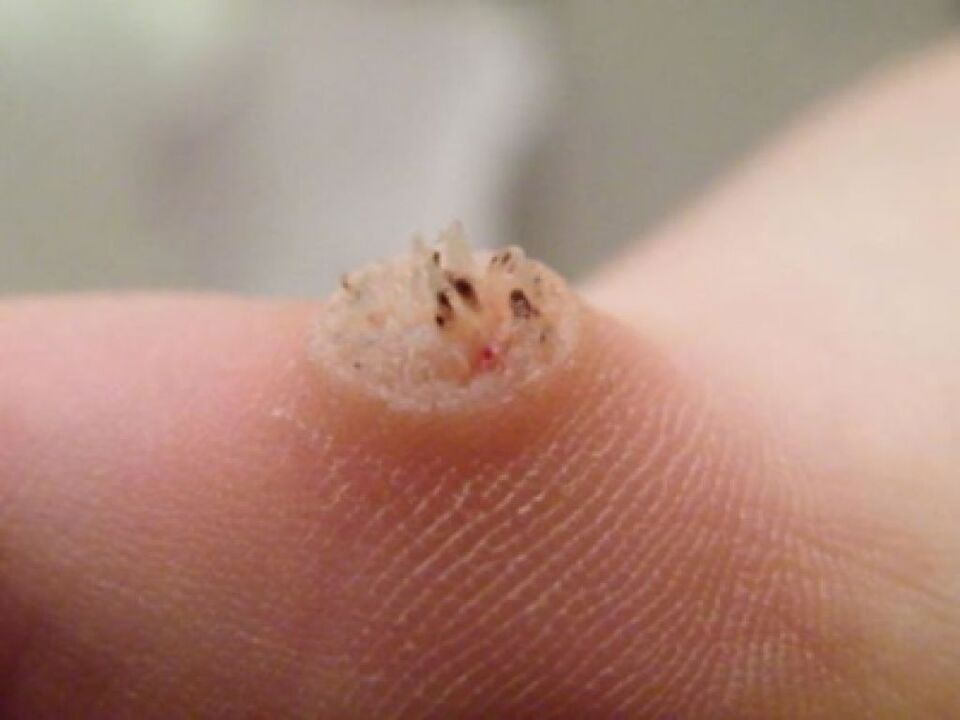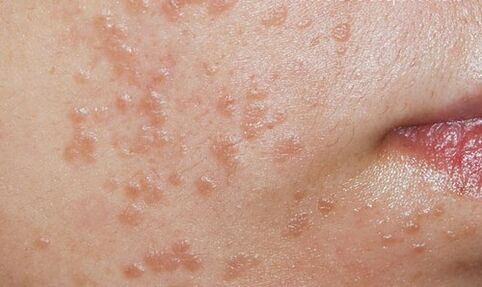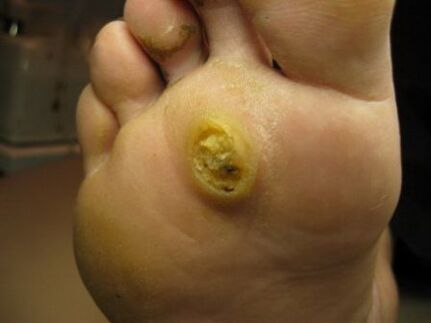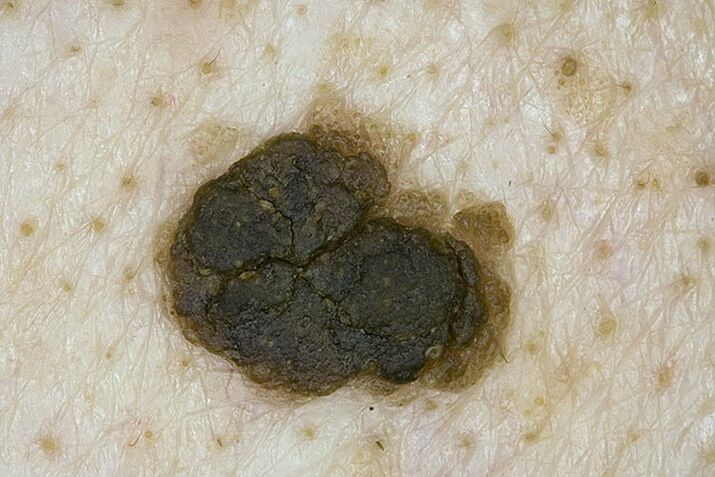It is necessary for each person to take a closer look at the types of papillomas in general terms. Such information will be useful in that some types of warts have a very high oncogenic level and if they appear on the body, a person can immediately consult a doctor.
Each of the types of neoplasms has its own unique external features and it is worth getting to know them a little more closely.
Common or vulgar wart - description
Papillomavirus carriers are 90% of the earth's inhabitants. For some, it can remain inactive for a lifetime, but there are those who cannot get rid of warts. Most often, on the skin, you can see the usual papilloma, which is caused by varieties of viral organisms numbered 7, 10, 12, 14, 15, 17, 19-24, 26, 27, 29, 55.

Papillomas of the vulgar type are manifested on the human body due to the following external features:
- the shape is round or hemispherical;
- the color is slightly darker than flesh or brown;
- rises above skin level by 2-4 millimeters;
- has a uniform and smooth structure, smooth texture;
- attached to the human body thanks to a special leg.
Such a problem can form on the arms, legs, back, face and neck. Some people confuse such benign formations with moles, but in fact, these two concepts are completely different.
Such a problem has no noticeable symptoms, warts of this type have a very low level of oncogenicity and do not require removal without fail. If a person wishes, the growth can be removed using laser therapy, liquid nitrogen freezing, special plasters, or standard surgical intervention.
Description of filiform warts
The varieties of papillomas can tell you exactly which genotype of the viral organism is causing the problem. Most often, filiform warts can be found on the neck or face area. They are small enough, located on a long leg and practically do not cause discomfort. Characteristic features of papillomas of this particular type should be called:
- fairly small, almost minute size;
- the leg is long and very thin, which looks like a thread;
- flesh or light brown;
- Quite soft and nice structure.
Filiform warts can appear on the eyelid, neck, near the mouth. If they grow in another part of the body, then there is nothing strange here, because the human papillomavirus can seem completely unexpected. Filamentous papillomas are also called anronorades and doctors do not give clear recommendations for their removal. When this particular type of problem occurs, there are no clear recommendations regarding removal.
Flat papillomas - main features

Flat warts are a fairly common type of papilloma, most often occurring at a young age.
On the body of adolescents, small flat warts are observed, and over time they disappear on their own.
The probability that a flat neoplasm will appear at a more mature age is also quite high, because the problem is caused by the virus varieties numbered 43, 55, 53 and some more.
In terms of appearance, this problem has the following characteristics:
- practically does not protrude above the level of the skin or the elevation is minimal;
- flesh tone or light brown;
- most often appears in a single variant;
- it does not cause any discomfort, it can have a minimum size or rather large.
Such a problem only causes visual discomfort, because they do not cause any special problems of concern. The doctor may prescribe antiviral therapy, which is caused by taking antiviral drugs. If a person experiences visual discomfort in the presence of a flat wart, then the papilloma can be removed surgically, with laser or cold cautery.
Sharp papillomas or warts
The most dangerous for humans are pointed papillomas. They are caused by viral organisms numbered 31, 33, 35, 39, 45, 51, 59, 70, 30, 39, 55, 57, 67, 69. Such formations have a very high oncogenic level, most often appear in the intima men's and women's areas.
The external features of genital warts that occur as a result of the activity of the human papillomavirus are considered:
- cone-shaped growths, of different sizes;
- a fairly high magnification above skin level;
- the presence of a wart is not in a single variant;
- a significant number of papillomas create a formation that is very similar to cauliflower in appearance;
- education not only on the skin, but also on the mucous membranes;
- flesh, light brown or pink.
The appearance of these growths in the intimate area causes a lot of discomfort. A person feels constant itching, feels uncomfortable during intimacy, and there may be a not too pleasant smell.
If the problem is identified in a woman, she will be offered a screening test. The treatment of the problem will depend directly on the specific diagnosis made by the doctors. If the formations have already become malignant, surgery is performed, chemotherapy is used. Refuting such a serious diagnosis, patients are still advised to remove the growths and take antiviral therapy.
Plantar warts - main features

Some HPV genotypes cause warts on the soles of the feet and the palms of the hands. They often resemble ordinary calluses, although they are quite painful. The main features of problem formations of this type should be called the following external manifestations:
- in color, the growths practically do not differ from the color of the skin;
- protrude slightly above skin level;
- they often resemble a small knot on the leg and have some mobility.
The discomfort of the growths occurs only because they appeared in such a zone. Due to excessive education, it is painful for a person to completely step on the foot, and if the papilloma is on the arm, then during the execution of some kind of robot there is great discomfort. It is imperative to remove such growths, since they can be very easily damaged, which often leads to blood poisoning.
Plantar warts have a low oncogenic level, but they are quite dangerous because they are easy to damage without even realizing it. With such a problem, it is necessary to conduct antiviral therapy, remove the growth surgically, with a laser or liquid nitrogen. After the operation, a small wound remains, but it heals completely in a few days.
Basal papillomas and senile warts
There are papillomas that occur exclusively in people of a certain age. These types of benign growths include basal end papillomas. These neoplasms are also considered senile warts (in the photo).

In terms of appearance, these benign growths can be described as follows:
- in color they practically do not differ from the standard skin color;
- rather soft structure;
- slight elevation above skin level;
- variations in terms of size: fairly large or small papillomas.
Such warts do not pose any danger. They cannot be removed, but if desired, the patient can always choose the most comfortable type of therapy for him. Such types of papillomas are quite inconspicuous on the photo, but in real life they are clearly visible during external examination.
Additional Information
In nature, there are about 150 varieties of papillomaviruses, which provoke the appearance of warts of various shapes and sizes on the skin. Papillomas are divided into types based on the strain of HPV a person was infected with.
People can develop warts of various types and sizes only after the body is greatly weakened, and if you notice such formations on the skin, it is worth remembering and taking into account the following information:
- sharp papillomas or warts that stick together always have a very high level of danger;
- when warts appear on the soles of the feet, mucous membranes, palms, even if they belong to a safe variety, they must be removed without fail;
- you should not try to cut warts of each type on your own, as this threatens to relapse and infect the whole body.
Each human body has its own characteristics, which also affects how exactly the human papillomavirus can manifest itself.
If a person notices a certain type of wart on the body, it is similar in description to one of the indicated varieties, he should immediately consult a doctor.
When education does not fit the above descriptions, it should not be ignored either, because everything can be caused by HPV.
Why does this problem exist in almost all people? Experienced doctors have not yet been able to identify in detail, but experts have learned to competently treat both external manifestations and the source of the problem. The external problem of each variety is an occasion to visit a specialist doctor. You can not ignore this, because everything can end very badly.
In custody
Therefore, if a person has an ordinary or flat wart, then he does not need to be afraid at all, but pointed growths do not always turn out to be benign, which is a reason for further diagnosis and immediate treatment.
Senile warts also do not manifest themselves in any way, and quite often they are not caused by HPV, but simply form due to age. Flat papillomas can become an age-related feature in adolescents and then disappear without a trace.
But you should not count on this, because the problem can be more serious. It is better to immediately go to a qualified medical specialist and competently solve the problem, so that later you will not encounter additional problems.
Among warts of all kinds, there are completely safe neoplasms and those that can cause significant harm to health. Both of these problems require competent diagnosis, and only then will the doctor decide what to do in a particular case. Everyone can learn to recognize the varieties of the problem, but there is no point in trying to treat it on your own.























